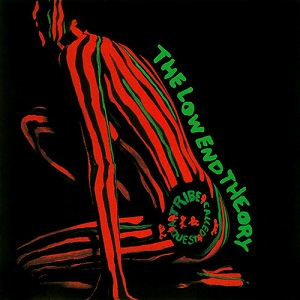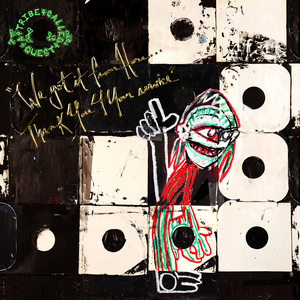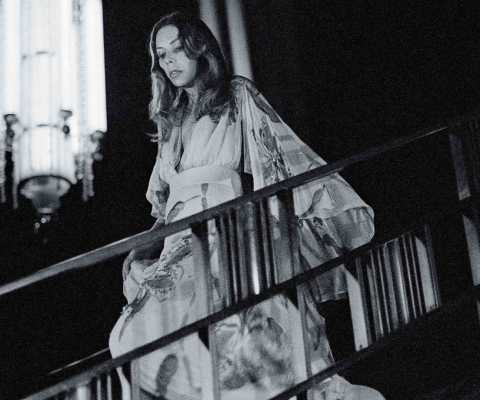Motion Picture Soundtrack is a column that explores the soundtracks of music documentaries and biopics. Using songs featured in each respective film or series, the column offers readers a primer on artists and bands worth loving, revisiting, and discovering anew. This week, we look at Beats, Rhymes & Life: The Travels of A Tribe Called Quest, Michael Rapaport’s on point documentary chronicling one of hip hop’s most influential and cherished groups.
Beats, Rhymes & Life: The Travels of A Tribe Called Quest (2011), Michael Rapaport’s raw-but-loving documentary on hip hop group A Tribe Called Quest, explores the connections and tensions that led to the group’s formation, ascension, breakup, and numerous reunions. Made up of MCs Q-Tip, Phife Dawg, and part-time member Jarobi White, as well as DJ/producer Ali Shaheed Muhammad, ATCQ released six albums, numerous singles, and some of the most visually striking videos in hip hop. They remain one of the genre’s most eclectic, beloved, and influential acts, and the film is acutely aware of this, featuring appearances by some of hip hop’s most well-known and important artists, including ?uestlove, all three members of the Beastie Boys, Kanye West, and De La Soul.
Released before the group’s final outing in 2015 (and before the tragic passing of founding member Phife Dawg in 2016), the documentary gives viewers insight into the group’s dynamic, their philosophies, and their creative process, including Tip’s production methods. We witness Phife’s struggles with diabetes (which sadly contributed to his passing in 2016); the pitfalls of fame, and stardom; Q-Tip’s perfectionism; the end of their creative chemistry by 1996’s Beats, Rhymes and Life; their eventual breakup after the release of The Love Movement (1998); and their subsequent reformation (and breakup. And reformation. This happens a lot. The personalities are strong, to say the least).
While Rapaport, known mostly for his acting and podcasting duties, is clearly infatuated with his subjects, respect is also given where respect is due: ATCQ’s collaborators and (famous) fans contribute to the group’s story, and in return, the members of ATCQ recognize and honour their own influences, including parents, early supporters, and those they sampled.
Anyone who loves hip hop (or, you know, music in general) is undoubtedly aware of these albums and songs, but for those of you who are not, this collection takes some of the band’s most popular songs, and mixes in some under-appreciated gems. I included their 2016 album We Got It from Here… Thank You 4 Your Service, which was released after the death of Phife Dawg. The two-disc set showcases the group’s unwavering experimental tendencies, and deserves to be held in the same high regard as their early ’90s output. The group honoured Phife Dawg’s legacy by touring one last time behind the album, after which they officially disbanded. I never got a chance to see them, but their legacy lives on through the music. Enjoy it. There’s truly nothing quite like it.
THE ALBUMS
The Low End Theory (1991)

Midnight Marauders (1993)

We Got It from Here… Thank You 4 Your Service (2016)

SONGS
“I Left My Wallet In El Segundo” from People’s Instinctive Travels and the Paths of Rhythm (1989)
A road trip story song about Tip leaving (re: losing) his wallet in El Segundo, “I Left My Wallet…” became the group’s debut single, and first video—a half colour, half black-and-white rip through the desert with a bummed out Tip lamenting his missing wallet. Influenced by Sanford and Son (El Segundo was a constant reference for patriarch Fred Sanford), the song’s humour and laidback groove established ATCQ as a clever, talented and alternative collective, whose esoteric lyrics, sample-heavy production, and creative videos set a precedence for decades of rappers to come. Everyone was taking notes.
“Check the Rhime” from The Low End Theory (1991)
A quintessential hip hop offering, and one of the best songs of the ’90s, “Check the Rhime” works its way through an Average White Band sample as Phife and Tip reminisce about Linden, boulevard hangs, and the routines and rhymes they would kick, long before all the tours, record company people (remember, they’re shady), and radio promotion took over. Released as The Low End Theory’s first single, the track features an unapologetic diss aimed openly at MC Hammer and his pop-rap proclivities. Ironically, even though it peaked at 59 on Billboard in 1991, “Check the Rhime” eventually became a radio staple, and has since become well-beyond quintessential (I slightly miscalculated, apologies).
“Can I Kick It?” from People’s Instinctive Travels and the Paths of Rhythm (1988)
The most obvious choice I’ll ever make for any list. When Tip raps “Rock and roll to the beat of the funk fuzz,” the song matches his proclamation, and worlds collide. The track is, for most, the first ATCQ song they’ll probably hear, a ubiquitous radio jam that gets played on alternative rock stations as much as hip hop ones. In one scene from the film, Tip discusses his discovery of Joe Dukes’s drumbeat from Lonnie Smith’s cover of “Spinning Wheel.” Mixed with the bassline from Lou Reed’s “Walk on the Wild Side,” the two samples form the backbone of the track, and over a decade after putting this together, his excitement is still palpable. Whenever I hear it, I concur.
The video is also amazing. At one point, Tip literally kicks “it.” *chef’s kiss*
“Jazz (We’ve Got)” from The Low End Theory (1991)
If you’re on a foreign path, then let me do the lead
Join in the essence of the cool-out breed
Then cool out to the music cause it makes ya feel serene
With the birds and the bees and all those groovy things
“Laidback” is too frantic a word for this liquid-cool slice of ’90s jazz-rap perfection. With its Blue Note Records-inspired sleeve art, “Jazz (We’ve Got)” proudly displays its influences, floating along on a Jimmy McGriff piano line while Phife and Tip deliver verses bursting with religious and musical references, name dropping collaborators, friends, and each other. The lone hook, Phife’s dancehall inflections, and protracted outro make this an unconventional choice for a single, but with this track, ATCQ weren’t just setting an example; they were delivering a statement: if “Check the Rhime” was a trip down memory lane, “Jazz (We’ve Got)” was its spiritual sequel, a soulful testament to the expressive power of hip hop.

“Buggin’ Out” The Low End Theory (1991)
YO! (That’s all, that’s it – . – – – – – )
“Buddy (Native Tongue Decision mix)” – performed by De La Soul, Q-Tip, Phife Dawg, Jungle Brothers, Queen Latifah, Monie Love from the Buddy single (1989)
Posse cuts have always been ubiquitous in hip hop. From Wu-Tang Clan’s “Triumph” to Odd Futures “Oldie,” giving everyone in your crew the opportunity to spit on a track celebrates the collaborative, communal nature of hip hop. Native Tongues was a ’90s collective based in New York and featuring numerous hip hop luminaries, including Jungle Brothers, Queen Latifah, Monie Love, De La Soul, and A Tribe Called Quest. In this underrated remix of “Buddy,” a track off De La Soul’s classic 3 Feet High and Rising (1989), the Native Tongues collective shines as member after member drops a quick verse about hanging with Buddy, Jimmy and Jenny…for the most part. Everyone is kinda rapping about something different, and the verses are all over the place, but it sounds like they’re all having fun. It may be long, and it may be surreal, but it’s a good time, which is exactly what a posse cut should be.
NOTE 1: This song isn’t available on Spotify (hmm…), but you can listen to it here. How convenient!
NOTE 2: Tribe’s own “Scenario” is a clear Posse Cut Classic™ (and features a young Busta Rhymes, hungry and ripping), but unfortunately, it’s not featured in the film, so this is its lone shout out.
“Bonita Applebum” from People’s Instinctive Travels and the Paths of Rhythm (1988)
Released as the second single from their debut album, “Bonita Applebum” is a quirky ode to the girl Tip loves, and her butt. Which he also loves. So this is technically an ode to both. With its cheeky (sorry…) subject matter and bashful, lovestruck vocals, “Bonita Applebum” is one of the group’s strangest singles, but also one of their most enduring and influential cuts. The song’s content, flow, and beat have been relentlessly appropriated (“Apple Bottom jeans,” perhaps?), and the track’s unconventional delivery (Tip’s cadence is practically nerdy) and bouncy production have influenced numerous producers, including Pharrell (who apparently listened to it hundreds of times when it was first released), and Prince Paul, who calls it a “hardcore love song.” In the film, famed radio personality and “The Voice of New York” Angie Martinez claims that “Bonita Applebum” is one of the reasons “chicks dig Q-Tip.” It’s not hard to see why.
“Excursions” from The Low End Theory (1991)
Back in the days when I was a teenager
Before I had status and before I had a pager
You could find the Abstract listening to hip hop
My pops used to say, it reminded him of be-bop
Are you kidding me? Like, seriously and truly and honestly, are you kidding me? That Mickey Bass sample from an Art Blakey track is everything, the group’s flow is impeccable, and the light trumpet makes me feel like I’m part of a hot New York night and the summer has just started. But also: say wha–?! This is the first song on your second record? Fuck a sophomore slump, this is it, starting off the group’s best record with a declaration: A Tribe Called Quest is here, pay attention. Experimentation and references abound, and jazz is the name of the game, with these opening lines telling you everything you need to know about ATCQ, and hip hop: take something you know, something you’ve heard before, something that’s important to you, then flip it, chop it, and recreate it, until it becomes yours. That’s the heart of the sample, the heart of hip hop, and the heart of ATCQ. This record is untouchable (Pharrell thinks so too), and “Excursions” is its manifesto.
“Get a Hold” from Beats, Rhymes, and Life (1996)
If you don’t know Dilla, you ain’t shit.
“Award Tour” from Midnight Marauders (1993)
Tribe’s success was built on the contrasting styles of Phife Dawg and Q-Tip, and if you ever needed proof, this is it. “Award Tour” plays off the duos strengths as both MC’s and characters, with Tip’s buttery flow complementing Phife’s higher, almost nasally delivery. This juxtaposition was key to the group’s early recognition, and remains one of the cornerstones of their legacy. The music video features innumerable close ups of our heroes, forced perspective, a shallow depth of field, and a cameo by De La Soul. All of these images are housed in a gilded picture frame, presenting the group’s music and performance as art.
Which is what it is. It is art of the highest order: powerful, original, inspirational. A Tribe Called Quest are all-encompassing. Their expressive, positive message, celebration of Blackness and Black culture, and lasting musical influence are a testament to originality and the pursuit of realness. They are a tribe. They are the Tribe. Are they on point? All the time. Now check the rhime, and kick it. You’ll be glad you did.
Beats, Rhymes & Life: The Travels of A Tribe Called Quest is slightly hard to find, but I urge you to seek it out. You won’t be disappointed.
RIP Phife Dawg, and long live A Tribe Called Quest.






Comments